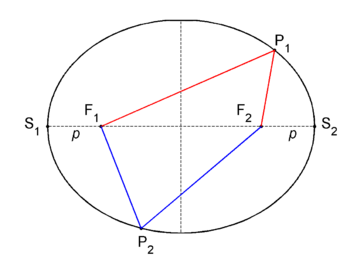Ellipse
In mathematics, an ellipse is a planar locus of points that have the same sum of distances to two given points. In figure 1 two fixed points F1 and F2 are shown, these are the foci of the ellipse. An arbitrary point P1 on the ellipse has distance |F1P1| to F1 and distance |F2P1| to F2. Let d be the sum of distances of P1 to the foci,
Another arbitrary point P2 on the ellipse has distance |F1P2| to F1 and distance |F2P2| to F2. By definition the sum of distances of P2 to the foci is equal d,
The horizontal line through the foci is known as the major axis of the ellipse. Traditionally, the length of the segment of the major axis bounded by its two intersections with the ellipse is indicated by 2a. Very often the horizontal segment itself is referred to as major axis, instead of the whole line of which it is part; from here on we will follow that usage. The vertical dashed line segment, drawn halfway the foci perpendicular to the major axis, is referred to as the minor axis of the ellipse. Clearly both axes are symmetry axes, reflection in either two of them transforms the ellipse into itself.
The right hand intersection of the major axis and the ellipse is a point designated by S2. Let the point S1 be the corresponding left hand intersection; both points are connected by reflection in the minor axis. The distance of focus F2 to S2 is |S2F2| ≡ p. By symmetry the distance |S1F1| is also equal to p. The distance of S2 to F1 is equal to 2a − p. The distance of S2 to F2 is equal to p. By the definition of the ellipse the sum is equal to d, hence
The sum of distances d is equal to the distance between S1 and S2.



